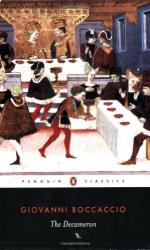|
This section contains 5,021 words (approx. 17 pages at 300 words per page) |

|
SOURCE: Forni, Pier Massimo. “Realism and the Needs of the Story.” In Adventures in Speech: Rhetoric and Narration in Boccaccio's “Decameron,” pp. 43-54. Philadelphia: University of Pennsylvania Press, 1996.
In the following excerpt, Forni examines Boccaccio's opening strategies for the stories in the Decameron, focusing on his ability to move from the familiar to the unusual.
The sixteenth-century pioneer of Boccaccio studies Francesco Bonciani observed from an Aristotelian perspective, that any given novella of the Decameron can be divided into three parts: a “prolago” (prologue), a “scompiglio” (the knotting of the plot), and a “sviluppo,” or “snodamento” (dénouement) (1972: 164-65). Of these, the “prolago” is to be regarded as a pre-narrative introduction. It is the part that gives the essential information about characters and facts, and fades into the first stirrings of action. Bonciani's notion of “prolago” coincides approximately with what modern students of fiction call “initial situation,” “background...
|
This section contains 5,021 words (approx. 17 pages at 300 words per page) |

|


